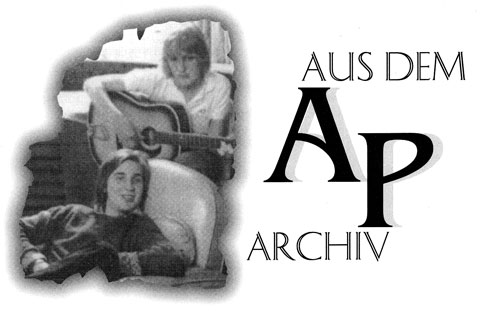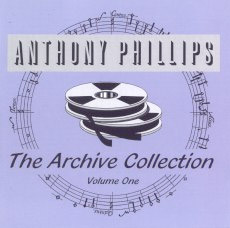- Article
- Read in 6 minutes
Anthony Phillips – The Archive Collection No. 1 – 2CD review
It is not only Genesis who open their archives. Their founding member Anthony Phillips has cleaned up his attic and gives his fans a deep look into his oeuvre – back even into his days in Genesis.
![]()

Riding high on the wave of nostalgia our Genesis heroes currently enjoy is Anthony Phillips who has just started a new, third series of albums entitled The Archive Collection. Its intentions overlap with that of the Private Parts & Pieces (but that material has frequently been refined or newly-written) and the Missing Links series, particularly The Sky Road, though that specializes in TV and library works.
Part one of the Archive Collection is based on the surprise find Ant made in his attic three years ago – the same find that brought to light the versions of In The Wildernessand Build Me A Mountain released on the Genesis Archive 1967-1975. Ant enlisted the help of Jonathan Dann from the official Anthony Phillips fanclub The Pavilion, and they compiled a foray through the years 1969 to 1990. Let us follow them on their chronological way:
Three demos of Ant with Mike Rutherford date back to September 1969. F Sharp, that one got its title because the top three strings on the guitar had been tuned to F sharp for the song, is an instrumental version (two twelve-string guitars) that is already very close to what later became part of The Musical Box – the ultimate digital proof that Ant was cheated out of the writing credits for this Genesis song. The demo for The Geese And The Ghost, then called 0 Instrumental and also performed on those two guitars, is stunningly close to the guitar parts of the 1974 album version; a later drumfill was improvised by knocking on the guitar body. F Sharp 2 is a previously unknown piece with R&B elements; overdubs for this piece were technically very difficult because the musicians heard the basis track only from a tiny speaker. Ant plays the drums, Mike is on bass and Richard Macphail swings the tambourine. In the summer of 1970 Ant recorded two more demos. God If I Saw Her Now is arranged like the album version on which Phil Collins and Viv McAuliffe would duet; on this demo the guitars sound less brilliant and Ant sings all the vocals himself.
 In Memoriam AD would later become Reaper (on Private Parts & Pieces); the prominent solo voice reminds of the alternate version Electric Reaper from the Scottish Suite (on Back To The Pavilion); the liner notes do not reveal who or what AD is. The piece was co-produced by Harry Williamson. The piano demo for Take This Heart was recorded in 1972; the hymn would later be recorded with the Charterhouse school choir and released on the extremely rare Charisma sampler Beyond An Empty Dream (Songs For A Modern Church). If you happen not to have that sampler you can piece the song together from the demo and the lyric book. A very pleasant instrumental called Rowey Song was also recorded that year, but lost and rediscovered only in 1997 along with the Rowey Reprise that has several guitars instead of one. Which Way The Wind Blows (1974) is identical with the album version (The Geese & The Ghost) except that Ant sings on this one. A comparison reveals that Phil plays around more with his voice, holds long notes, sings the „s“ sounds voiced and does a better job of interpreting the lyrics by means of articulation and phrasing. The instrumental coda is left out; Mike plays the guitar and the glockenspiel on this song.
In Memoriam AD would later become Reaper (on Private Parts & Pieces); the prominent solo voice reminds of the alternate version Electric Reaper from the Scottish Suite (on Back To The Pavilion); the liner notes do not reveal who or what AD is. The piece was co-produced by Harry Williamson. The piano demo for Take This Heart was recorded in 1972; the hymn would later be recorded with the Charterhouse school choir and released on the extremely rare Charisma sampler Beyond An Empty Dream (Songs For A Modern Church). If you happen not to have that sampler you can piece the song together from the demo and the lyric book. A very pleasant instrumental called Rowey Song was also recorded that year, but lost and rediscovered only in 1997 along with the Rowey Reprise that has several guitars instead of one. Which Way The Wind Blows (1974) is identical with the album version (The Geese & The Ghost) except that Ant sings on this one. A comparison reveals that Phil plays around more with his voice, holds long notes, sings the „s“ sounds voiced and does a better job of interpreting the lyrics by means of articulation and phrasing. The instrumental coda is left out; Mike plays the guitar and the glockenspiel on this song.
1975 was the year the „kiddies’ mix“ of The Geese & The Ghost developed; you can hear an excerpt from part one in which the wood wind instruments (Ant’s brother Rob on oboe, John Hackett on flute) take centre stage. This version was considered well-suited for children’s programmes, though it was never actually used for that. Two demos for the Wise After The Event album date from 1977. Beside The Water’s Edge was a piece Ant wrote with Mike in 1969; Ant sings and accompanies himself on the guitar. It is not actually a boring piece, but Ant did well to include other material on the album instead. The Hunt Song is a different story altogether. Hunt Song is the original title of Now What (Are They Doing To My Little Friends?). Ant plays several guitars, sings and gives a rare mellotron performance on this great song.
1978 is represented by four pieces. Lucy Will is a demo that comes quite close to later version of the Sides album. There is also a brief excerpt from Holy Deadlock which features vocals by Ant, Dale Newman and Dan Owen as well as Michael Giles’ percussion. After that it is Catch You When You Fall; Ant recorded this song with Michael and bass player John G. Perry (spot the bass vibratos) for Sides, but held it back because of unsatisfactory lyrics that cannot be heard here. It is a merry little tune, almost muzak and it sounds as if the Wombles went on a hike in the mountains on a sunny day…
Study in G had been released before in written form only. It was part of Ant’s Six Pieces For Guitar (seven, actually) published at Josef Weinberger’s in 1980. The recording is from a demo tape for Weinberger and it proves that these notes can be played… In 1981 Ant went into London’s Logorhythm studios to record music for the six-part documentary Rule Britannia. The music used for the final credits is included in this album; it sounds a bit like 7984 or Finger Painting. This project brought Ant into contact with Japanese percussionist Joji Hirota (who did not play on this piece).
Next are two instrumental mixes of songs from Invisible Men (1983), Exocet and The Women Were Watching; both are slightly different from the instrumental backing tracks on the album, but they are peculiar and strong enough to warrant repeated listening. Those who could not get the vinyl sample Double Exposure with Ant’s Promenade for twelve-string guitar and synth strings can now at least listen to the alternative guitar-only version that Ant recorded in 1986. It is not a full replacement, but at least in CD quality. Back To Pluto (1987) is an explosive synthesizer piece along the lines of the space songs (e.g. Pluto Garden) from Slow Waves, Soft Stars; for the first time since 1992 Sir Ralph appears again: “Features Ralph Bernascone on meteorite”.
Then there are two recordings from the 1990 Slow Dance sessions on this CD: A single mix with a hitherto unknown variation on one of the themes that Virgin did not want to release as a single, and The Burnt-Out Cattle Truck Hits The Road. The longer and the more absurd the title the shorter and less relevant the piece with Ant: This is a very short intermezzo made up of guitar recorded backwards and synthesizer.
With this, the CD is brim-full. But Ant had material left so it was decided to number the first 1000 copies of the CD and add a bonus EP with five more recordings. What Is The Meaning?and Farewell are from Ant and Mike’s 1969 demo tape . They share the space on track 3; their gloomy mood is enhanced by the not quite brilliant audio quality of the demo tape as well as Ant’s organ overdub on What Is The Meaning?. The demo of Queen Bettine, a Phillips / Rutherford song, was recorded in 1972 with guitar and vocals; the guitar part is very pleasant, though the intro breaks off a bit too abruptly; Ant has some difficulties with his intonation, and it seems a bit paradoxical when with his peaceful, thin voice he sings that “now is the time to be loud”. The song has a very soothing atmosphere and if you cannot sing yourself you should not pick at Ant’s vocals from when he was 21, which is why I move on to Kip PJ: Behind this confusing title there is an excerpt from an unknown 1978 song played backwards.
The final song is a lullaby, a long typical Anthony Phillips piano piece along the lines of the romantic, less experimental pieces from, say, Ivory Moon.
The booklet with its two-colour cover has an introduction by Alan Hewitt of “The Pavilion”, greetings from John G. Perry (bass player on Wise After The Event and Sides and a fantastic overlooked composer in his own right) and Andy Latimer of Camel. Then there are liner notes to every track by Jonathan Dann and a word of thanks by Ant. It also has a photo by Ant from the late 70s and a portion of the photo than can be seen at the top of page 16 of the Genesis Archive booklet, in better quality, though. The Archive Collection vol.1 is a must for all fans of Anthony Phillips and Mike Rutherford. The early version of The Musical Box makes the album interesting for Genesis fans, and it comes at a very reasonable price. The only thing I would not recommend this compilation for is as an introduction to the music of Anthony Phillips.
by Andreas Lauer
translated by Martin Klinkhardt

